In India, an estimated 22% of the population do not have access to safe drinking water; more than three-fourth do not have proper sanitation facilities, leading to high levels of water borne diseases and deaths, particularly in rural areas. There is gross disparity in availability of these services across country. The World Bank estimates that 21% of communicable diseases in India are related to unsafe water. In India, diarrhoea alone causes more than 1600 deaths daily. Especially women, who are responsible for water in the household, suffer from the lack of clean water. Hygiene practices also continue to be a problem in India. Latrine usage extremely poor in rural areas of the country; only 18% far lower than MGD targets and now SDG Goal 6.
Responding to MDG and SDG goal 6 YFA has initiated a comprehensive programme in partnership with local panchayats and SujalArogyaSamiti’s to get access to clean water and sanitation. A case example of our work further narrates our commitment.
Case study of Kanchiroapalli – a partnership of panchayat and SujalArogyaSamiti
Ground Reality:
Water scarcity and access to safe drinking water has been a pressing issue engulfing countries the world over and Telangana is not untouched to it. Rural areas of this state are characterised by agricultural activities and water influences the development of this sector. Inadequate rainfall increases the pressure on ground water table, thus reducing its level and further adding to water scarcity problem and this in turn affects the ecological balance.
Mahbubnagar, a second largest district is witnessing decade long drought. For the past ten years the district received less than that of 754.2 mm which is the normal rainfall. The rainfall in the district is scanty and highly variable. Water scarcity and access to safe drinking water has been a pressing issue in the district. Lack of rainfall has been resulted in reduced groundwater level in the district leading to no water availability for irrigation, livestock’s and irrigation purposes. In Mahbubnagar district, majority of the population does not have access to the defined 40 LPCD’s of safe water/person/day.
Present Situation:
Further, a research hydrogeochemical investigations carried out recently in the Mahabubnagar district revealed that the groundwater is alkaline in nature. Nearly 5 % of groundwater of the study area shows concentrations higher than the prescribed limit of 1500 micromhos/cm for drinking purpose. The higher values indicate that ionic concentrations are more in the groundwater. Nitrate concentration in the groundwater of the area varies from 1.1mg/l to 112 mg/l, while 43% of the groundwater contains more than 45 mg/l of nitrate which is the prescribed limit for drinking purpose and is attributed to the migration of nitrates from anthropogenic sources during rainy season. While 46% of groundwater shows excess fluoride prescribed for drinking purpose. It is observed that the people living in high fluoride concentration areas are suffering from mottled teeths and also knee joint pains especially in younger people. Moreover, dental and skeletal fluorosis is at alarming stage in local resident of these areas.
Village Facts:
Kanchraopallia Gram Panchayat comes under, Pebbiar Taluka and thus falls in the Mahbubnagar district. The village has a total geographical area of 1280 Ha with a population of 4200, has a total of 610 households (approx.). Inhabitants of the Panchayat serve the requirement of drinking water with number of sources for drinking water purpose. Structures like overhand tank, water taps connected with OHT, hand pumps, borewells and open wells are used for drinking purpose and domestic use.
The village has 10 Hand Pumps and 4 of them are not working. There are 4 bore wells located in the village of one is dried out and need to de-silt. These bore wells are connected to OHT. The water lifted from the well pumping to the main tank for onward supply to the individual households without purifying the water. 410 water taps are connected to the OHT for domestic and drinking purpose of which 20 are not in a working condition. The structure was created by the government and not been owned by the Gram Panchayat. Thus Gram Panchayat is responsible for its operation and maintenance. Water is supplied all through the year and the individuals use water for drinking, domestic and livestock purpose. The status of supply channel is not good; there is no effort made towards chlorination and cleaning of the tank. There are leakages in the pipeline leading to wastage of water. Drinking water through the OHT is accessible more than 6 months but during summer; the supply is restricted to once in a day only.
Need for RO Plant:
Knowing the fact of polluted ground water, YFA team has organised an orientation programme for SujalSamithi. Awareness has been generated among the participants about florid water and other excessive minerals prevailing in available water and how they affect health condition. During this orientation, YFA team has introduced River Osmosis (RO) plant concept as a solution to this situation.
Setting of RO Plant
Kancharoapally villagers were using open well and overhead tank water for drinking water purpose. Though maintenance of these water structures is the responsibility of Panchayat, these water structures were in untidy conditions and water available is having dust, mosquitos, warms and dead plants. People using this water often suffered from vomiting, body pains, fever, motions etc. Knowing this fact and after understanding the need of RO plant and how having this can provide safe drinking water; an initiative was taken by KancharaopallySujalSamithi to set up such plant in their village. The concept was then discussed by SujalSamithi in several meetings and unanimously took decision to install RO Plant in the village. An initial budget was prepared with the help of YFA team. SujalSamithi has decided their contribution (Rs.50000) and support was provided from EU-IWRM project. A room, water and power supply was made available by Gram Panchayat.
With the collective efforts, a RO plant was set and inaugurated by MLA. Looking at the enthusiasm of the village especially the SujalSamithi, MLA declared Rs.6 lacs for fixing of water pipe line with the RO plant. This was a big achievement of convergence for KancharaopallySujalSamithi.
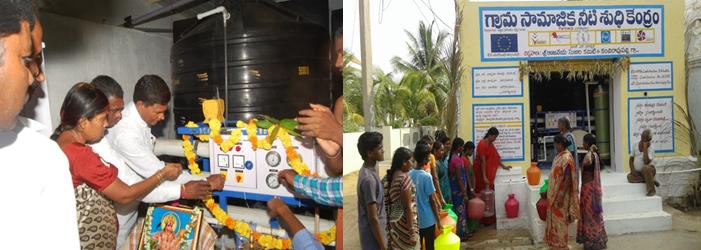
Reducing women’s drudgery and access to water improves women’s health and empowers women- experiences of women
Rationale:
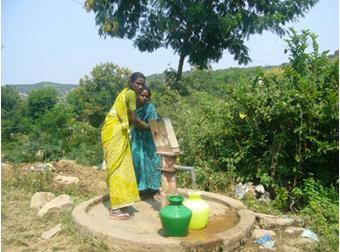 Women manage water resources not only for productive uses, but also for domestic purposes. Sanitation and hygiene for good health are their responsibility and they often play an active role in the construction and preventive maintenance and repair of sanitation facilities. Women and girls also walk for hours to fetch drinking water. On the other hand, this fosters social and group cohesion and provides women with an opportunity to communicate with other women and people outside their homes. But on the other hand, it exposes them to threats of violence and to health hazards. It also takes time away that might be used for leisure or more productive activities. The central role of women in water management was recognised in the Dublin principles (adopted at the international conference on water and the environment). Since then, policy makers have made attempts to incorporate gender issues in water development initiatives including in the resolution declaring 2005-15 the international water for life decade. However, these policies have not been adequately translated into practice and attempts in some programmes to involve women in water management initiatives have met with only modest success. The reasons for these disappointing results range from lack of understanding of gender issues by project staff, to lack of will, to lack of capacity, prevailing cultural norms and the use of relevant tools to mainstream the gender relevant activities.
Women manage water resources not only for productive uses, but also for domestic purposes. Sanitation and hygiene for good health are their responsibility and they often play an active role in the construction and preventive maintenance and repair of sanitation facilities. Women and girls also walk for hours to fetch drinking water. On the other hand, this fosters social and group cohesion and provides women with an opportunity to communicate with other women and people outside their homes. But on the other hand, it exposes them to threats of violence and to health hazards. It also takes time away that might be used for leisure or more productive activities. The central role of women in water management was recognised in the Dublin principles (adopted at the international conference on water and the environment). Since then, policy makers have made attempts to incorporate gender issues in water development initiatives including in the resolution declaring 2005-15 the international water for life decade. However, these policies have not been adequately translated into practice and attempts in some programmes to involve women in water management initiatives have met with only modest success. The reasons for these disappointing results range from lack of understanding of gender issues by project staff, to lack of will, to lack of capacity, prevailing cultural norms and the use of relevant tools to mainstream the gender relevant activities.
The initiative:
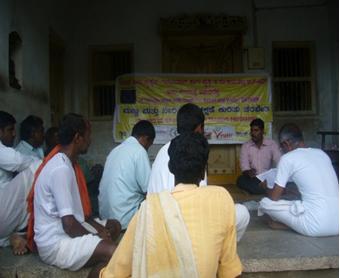 YFA/EU/Vrutti has initiated a water governance project focusing on vulnerable communities particularly on women and children in various locations of Andhra Pradesh and Karnataka. The project emphasised on involving women in decision making process and promoted women’s participation in managing and running SujalSamithis an organisation established at the local level for efficient governance by the initiative by vulnerables. It was also realised that the lack of recognition of the role women play as decision makers in one of the major reasons for women’s poor access to productive resources. As a result, most of the water initiatives that aim at enabling poor to improve their livelihood failed to taken into account women’s concerns about the multiple uses of water. The initiative further recognised that women use water for agriculture & livestock, domestic tasks, health and sanitation. While men’s water use priorities mainly revolve around agriculture. Based on such understanding the project staff started identifying initiatives which can reduce drudgery of women and at the same time providing access to qualitative water. The staff also recognised the need for training for improving the capacity of personnel and community workers involved with the initiative. The intensive consultation with women members resulted in identifying the most prioritised needs which includes a) immediate access to water which can reduce their long walks, reduce fatigue and save time; b) reduce manual labour and physical pain while operating handpumps to fetch water for household use as they have to transport at least 200-300 litres of water depending on the members of each family.
YFA/EU/Vrutti has initiated a water governance project focusing on vulnerable communities particularly on women and children in various locations of Andhra Pradesh and Karnataka. The project emphasised on involving women in decision making process and promoted women’s participation in managing and running SujalSamithis an organisation established at the local level for efficient governance by the initiative by vulnerables. It was also realised that the lack of recognition of the role women play as decision makers in one of the major reasons for women’s poor access to productive resources. As a result, most of the water initiatives that aim at enabling poor to improve their livelihood failed to taken into account women’s concerns about the multiple uses of water. The initiative further recognised that women use water for agriculture & livestock, domestic tasks, health and sanitation. While men’s water use priorities mainly revolve around agriculture. Based on such understanding the project staff started identifying initiatives which can reduce drudgery of women and at the same time providing access to qualitative water. The staff also recognised the need for training for improving the capacity of personnel and community workers involved with the initiative. The intensive consultation with women members resulted in identifying the most prioritised needs which includes a) immediate access to water which can reduce their long walks, reduce fatigue and save time; b) reduce manual labour and physical pain while operating handpumps to fetch water for household use as they have to transport at least 200-300 litres of water depending on the members of each family.
Once the most important priorities identified the staff started enumerating the village water infrastructure and at the same time scouting for appropriate technologies which can reduce the physical pain and drudgery for water collection.
The Process and case studies:
The women and men members of the SujalSamithis participated in listing of functional water sources including those required immediate repair which can augment the water resources. The committee calculated village wise domestic and household water needs and compared with the existing functional water resources. It was realised by the committee members in all the 19 project villages that the existing functional water resources will not be sufficient for fulfilling the needs. After several discussions the women came forward with an idea of repairing all the non-functional water infrastructure i.e. handpumps so that they can get enough water at their door steps. When YFA questioned that why this water infrastructure is not repaired for such long period then the women said water is not the priority of men in the panchayat and society. Together with SujalSamithi and panchayat the staff prepared a comprehensive proposal to the district administration and mobilised at least 30% of the costs involved for repair of handpumps, laying pipelines and flushing of water sources. The efficient strategy of repairing non-functional water sources would have not thought by men but for the women’s involvement in the process. The repairs led to improved water supply to the households and now easily accessible near to their homes says-Rakkibai of Bodabanda, Sunitha of Minaspur and Chandramma of Madepally village. Kavithamma of Dharmapur village says the new borewell provided additional water near to their homes and reduced their drudgery, reduced the psychological stress to fetch water, physical pain and improved their health and availability of leisure time for their children.
An example of Ball Bearing technology to reduce drudgery and physical pain
 The other most important priority identified by women was to address the issue of physical pain and drudgery for pumping water through manual pushing of handle bar of handpumps. They complained that many of times they will have shoulder and neck pains which required medical attention. Realising such important need of women members the project staff scouted in search of technologies to several research institutions such as Walamtari, Universities and NIRD but without success. At this juncture the Team Leader Mr.JM.Ghatage of Karnataka project visited a local technician at Yadgir and discovered that the local technician has a technical solution of using Ball Bearings which can reduce the energy used by women in pumping water. The technology can also reduce the physical pain, drudgery and time taken for pumping to fill a pitcher of the capacity of 15-20 litres. We asked Saritha of Kakalwar village that how much time she used to spent for pumping for a pot of water before fixing of Ball Bearings. She informed that it used to be around 5-8 minutes but now it takes around 2-4 minutes and also reduction in shoulder and neck pain. The Ball Bearing technology found to be cost effective as each pump requires an investment of Rs.5330 as one time investment reducing the chances of repairs in comparison to the traditional handpumps. The technology found to promising but the local government functionaries finding it difficult to accept as the technology does not required repeated repairs unlike traditional handpumps. Many of times these handpumps found to be kept idle as the government functionaries would not responded and attend the repair work of handpumps and the women of the village would suffer psychologically and physically. The women members of the village Chinnakar, Burgapally, Yanagundi, Kakalwar, Budur, Nazrapur and Keshwar express their joy and satisfaction in addressing and fulfilling their needs by the collaborative initiative of EU/YFA/Vrutti, panchayat and SujalSamithis.
The other most important priority identified by women was to address the issue of physical pain and drudgery for pumping water through manual pushing of handle bar of handpumps. They complained that many of times they will have shoulder and neck pains which required medical attention. Realising such important need of women members the project staff scouted in search of technologies to several research institutions such as Walamtari, Universities and NIRD but without success. At this juncture the Team Leader Mr.JM.Ghatage of Karnataka project visited a local technician at Yadgir and discovered that the local technician has a technical solution of using Ball Bearings which can reduce the energy used by women in pumping water. The technology can also reduce the physical pain, drudgery and time taken for pumping to fill a pitcher of the capacity of 15-20 litres. We asked Saritha of Kakalwar village that how much time she used to spent for pumping for a pot of water before fixing of Ball Bearings. She informed that it used to be around 5-8 minutes but now it takes around 2-4 minutes and also reduction in shoulder and neck pain. The Ball Bearing technology found to be cost effective as each pump requires an investment of Rs.5330 as one time investment reducing the chances of repairs in comparison to the traditional handpumps. The technology found to promising but the local government functionaries finding it difficult to accept as the technology does not required repeated repairs unlike traditional handpumps. Many of times these handpumps found to be kept idle as the government functionaries would not responded and attend the repair work of handpumps and the women of the village would suffer psychologically and physically. The women members of the village Chinnakar, Burgapally, Yanagundi, Kakalwar, Budur, Nazrapur and Keshwar express their joy and satisfaction in addressing and fulfilling their needs by the collaborative initiative of EU/YFA/Vrutti, panchayat and SujalSamithis.
——————————————————————————————————————————————————————-
The story of Minaspur Village:
Minaspur village situated on the boarders of Andhra Pradesh and Karnataka. Probably it is farthest village from the taluka headquarters of Gurmatkal and the district headquarters of Yadgir. People depend on agriculture and the village has one of the largest traditional tank which irrigates more than 800 acres. In spite of good rainfall and water resources the village typically suffer from shortage of drinking water and saline ground water and also contained fluoride. The women members of SujalSamithi informed that they trek long walk for fetching water and the water sources are few. Fortunately the community resource person Sunitha brought to the notice of the SujalSamithi about a traditional well with good water but it requires a motor to pump the water from the depth otherwise require manual pulling of water by women.It also requires a filter for purifying the water as it may contain bacteria. The women thus demanded the support from the men members of the SujalSamithi and requested contribution from the panchayat. It took some time to initiate the work and the women continuously pressurised the members to initiate the work. The committee thus passed a resolution and procured the motor, pipes, water tank and a filter. Today the women of the village rejoices on the availability and access to safe drinking water near to their households and at the same reducing their drudgery, physical pain and stress. They extend their sincere thanks to EU/YFA/Vrutti for the support to women.
Learnings:
– The project addressed the strategic needs of women through affirmative action in repairing the water resources and implementing technical solutions to reduce drudgery and improve health wellbeing of women and girl children.
– Women CRP’s were particularly recruited as the pressure of women staff members can be reassuring and become an effective tool to guarantee activities information flow for setting-up the activities.
– Establishing at least 60% quota in SujalSamithis as members so as to ensure women’s participation in decision making processes.
– It is learned that unless the project team and men of the panchayat / government staff are not sensitized and trained the inclusion of women’s needs may not be possible to achieve.
– Adequate measures undertaken during the design stage to respond to the needs of the poorest women, particularly from the dalits and tribal women to assure equality. This requires sensitivity and commitment of the staff.
————————————————————————————————————————————————————-
Case study of Minaspur RO:
Background:
Water is a basic necessity for life. Unfortunately not all water is safe for human consumption. Water from contaminated sources causes numerous diseases and untimely death. The fact that human beings need water and cannot live without it forces them to use it even for drinking purpose from any contaminated source as the result many people suffer or die from water borne disease. WHO estimates that over 21% of communicable diseases in India are water-borne. Diarrhea is a major cause of death in children under 5 and parasitic infections are caused by contamination of water and poor sanitation, leader to stunted growth and debilitation. Skin and eye infections are also caused by contaminated water and high mineral content in water leads to fluorosis, dental decay and weakened bones. The situation is worse in North Karnataka region of project district Yadgir. Also access to water supply and sanitation is a fundamental need and a human right. Access for the poor is a key factor in improving health and economic productivity and therefore an essential component of any effort to alleviate poverty (WHO/ UNICEF Global water supply and sanitation assessment report, 2011). Access to water and sanitation services and quality in North Karnataka region and in the project district Yadgir in particular is very low.
The situation at the village-Minaspur:
The village is situated on the borders of Mahabubnagar and Yadgir districts. The population of the village speaks both Kannada and Telugu. Being in the boarder of the village the support and attention by the governments found to be marginal. Many of the existing water sources in the village has high fluoride content of 1.1 mg/L where as it requires to be around 0.8-1.0 mg/L. Similarly, the water tests found TDS levels at 1082 mg/L whereas desirable to be there at 500 mg/L. The hardness of the water found to be higher at 480 mg/L and total alkalinity found to be 470 mg/L whereas it needs to be around 200 mg/L. Such situation found to be unacceptable to the people of the village and many of them have complained about back aches, gastro entities, skin diseases and unacceptable for drinking water purposes.
About YFA-Vrutti/EU-IWRM Initiative:
YFA has identified the village as one of the major focal village for implementing a collaborative programme with Minaspur panchayat to demonstrate people and panchayat led water governance model. As a part of the pre-project activity the YFA conducted a detailed micro plan with the people to identify their most desirable felt need. During the discussions the issue of revitalizing the local water resources including existing water infrastructure came as a priority.
The Objective:
Based on the micro planning undertaken at the village and the priorities identified by the people the following objectives thus defined by the people themselves:
To revitalize the existing water sources and promotion of water infrastructure to augment qualitative water resources.
To initiate collaborative action and user fees to manage and maintain the water resource created.
——————————————————————————————————————————————————–
The process of decision making:
The desire of having a permanent water source was the major agenda of the Sujalsamiti ever since it has come into being. The women members led by very active women CRP highlighted the need for a RO unit as many of the women and children experience skin ailments and gastro problems. Chandra Reddy the President of SujalSamiti informed that the water from the Bore wells is unfit for drinking and there must be some minerals which affect the health of the people. Together with CRP the president of the Samiti organized several meetings for establishing a RO unit initially members were reluctant as the process required huge financial resources and the Samiti was not in a position to mobilize around Rs.5 lakhs. They also approached the ZillaParishad for the support but somehow the required resources could not be mobilized. Finally the approached YFA-Vrutti and EU for the assistance. During the initial years of the project the programme had limited financial resources for other smaller activities and therefore, YFA could not give assurance for the purpose. However, the team of YFA informed that they would discuss amogst the consortium partners for necessary grant and the SujalSamiti must collect at least Rs.50000/- as their contribution. In addition to the cash contribution YFA also suggested to identify a separate room along with a bore well for supplying sufficient water for RO unit and uninterrupted electricity supply. The SujalSamiti readily agreed to mobilize the cash contributions and informed that they would approach ZP and local panchayat including Electricity Department for necessary support. It took really long time to get all the support including mobilization of local contribution. After the process initiated it was also discussed about the maintenance part by the Sujal samite.
The Process of Implementation:
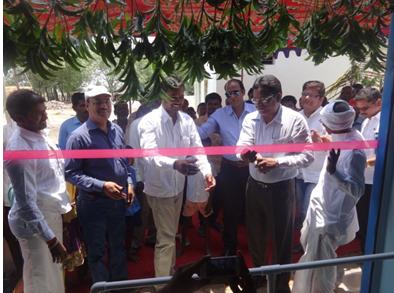 Once the SujalSamiti collected the resources including mobilization of infrastructure, YFA consulted Vrutti for identification of RO vendors. Vrutti informed that they are already in touch with TATA Projects ltd and suggested to engage the same vendor. YFA then placed order contributing Rs.3.83 lakhs with a request to install, train and support for maintenance. On the part of SujalSamiti they mobilized maintenance costs and opened a separate Bank Account. A local youth was trained to maintain the RO unit in cooperation with M/s TATA Projects Ltd. It was further requested to the vendor through Vrutti to conduct a detailed onsite technical training for management and maintenance. The SujalSamiti then decided to provide clean water to local households on free of cost for the initial two days. Thereafter, the Samiti has agreed to charge Rs. 3 for every 20 litres of water. Another Sujalsamiti member has also agreed to identified the market in the neighbouring villages. Today the communities led by SujalSamiti has taken the total charge of the infrastructure and happily managing.
Once the SujalSamiti collected the resources including mobilization of infrastructure, YFA consulted Vrutti for identification of RO vendors. Vrutti informed that they are already in touch with TATA Projects ltd and suggested to engage the same vendor. YFA then placed order contributing Rs.3.83 lakhs with a request to install, train and support for maintenance. On the part of SujalSamiti they mobilized maintenance costs and opened a separate Bank Account. A local youth was trained to maintain the RO unit in cooperation with M/s TATA Projects Ltd. It was further requested to the vendor through Vrutti to conduct a detailed onsite technical training for management and maintenance. The SujalSamiti then decided to provide clean water to local households on free of cost for the initial two days. Thereafter, the Samiti has agreed to charge Rs. 3 for every 20 litres of water. Another Sujalsamiti member has also agreed to identified the market in the neighbouring villages. Today the communities led by SujalSamiti has taken the total charge of the infrastructure and happily managing.
The change:
Today Sunita and majority of the women of Minaspur village are happy a lot. Sunita says, that the RO unit will reduce the existing water borne diseases and feels happy to take the water to her home as the water found to be safe and sweet. YFA once again collected the water samples and compared the data with previous water test report of 14th June 2012 with respect to various elements as shown in the following comparative test report samples conducted on 14th June 2012 (Before) and 16th May 2015 (after establishing RO unit).
| Before Installation of RO | After Installation of RO | |||
| Test parameters | Units | Values | Units | Values |
| pH | Mg/l | 7.21 | Mg/l | 6.92 |
| T. Hardness | Mg/l | 480 | Mg/l | 40 |
| Chlorides as CI | Mg/l | 228 | Mg/l | 10 |
| Total Dissolved Solids | Mg/l | 1082 | Mg/l | 72 |
| Calcium as Ca | Mg/l | 48 | Mg/l | 8 |
| Magnesium as Mg | Mg/l | 87 | Mg/l | 4 |
| Sulphates as SO4-2 | Mg/l | 38 | Mg/l | 2 |
| Nitrate (as NO3) | Mg/l | 1.3 | Mg/l | 0.8 |
| Fluorides as F | Mg/l | 0.8 | Mg/l | 1.0 |
| T.Alkalinity as CaCO3 | Mg/l | 470 | Mg/l | 35 |
| Iron | Mg/l | 0.21 | Mg/l | 0.10 |
Lessons learned:
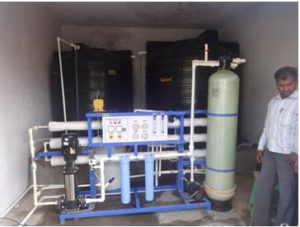 – It is well known fact that wherever communities are involved the programme will have high amount of success and ensures sustainability as the case suggested.
– It is well known fact that wherever communities are involved the programme will have high amount of success and ensures sustainability as the case suggested.
– The high amount of contribution can be achieved provided the need emerges at the local level as it happened with MinaspurSujalSamiti.
– Transparency and accountability will assure quality inputs and participation by all the affected particularly women and children as happened in the village. The women members and child parliament of Minaspur village sufficiently motivated the parents and male members.
– Community participation ensured better sanitation and overall cleanliness of the village
